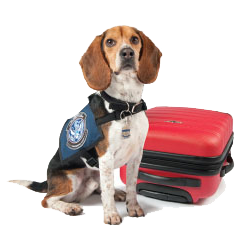International Traveler: Fruits and Vegetables
[ Back ]
The United States restricts or prohibits the entry of many agricultural products, which can carry foreign pests and diseases that harm American agriculture and our environment. A major pest or disease outbreak could mean higher grocery bills, shortages of certain foods, and devastating losses for our farmers and ranchers. Help us keep American agriculture healthy by following the guidance on this page about products you may want to bring into the United States.

Are you traveling from Canada by Land? Find out which meat, poultry and pet food products that you CAN and CANNOT bring back to the U.S. from Canada's land border. Air travelers should refer to the guidance listed below.
Fruits and Vegetables that you CAN and CANNOT bring back to the U.S. from other countries (choose below).
- Fresh
- Almost all fresh fruits and vegetables (whole or cut) are prohibited from entering the United States because of the potential pest and disease risks to American agriculture. This includes fresh fruits or vegetables given to you on your airplane or cruise ship. Please plan to leave them behind.
- Frozen
-
As with fresh fruits and vegetables, almost all frozen fruits and vegetables are prohibited from entering the United States because some pests and diseases can survive very cold temperatures. Please plan to leave them behind.
- Canned
-
Travelers may bring commercially canned fruits and vegetables into the United States as long as you declare them on your U.S. Customs form. Home-canned products are not allowed entry because canning practices can vary and may not remove all pest and disease risks.
- Dried
-
Most dried fruits and vegetables are not allowed into the United States without meeting
special requirements to prevent the introduction of pests and diseases.
The following dried products are generally allowed but you must declare and present them to U.S. Customs and Border Protection for inspection:
- Beans
- Dates
- Figs
- Nuts (but not chestnuts or acorns)
- Okra
- Peas
- Raisins
- Szechwan peppercorns
How Do I Declare Agricultural Items?

USDA-trained dogs help sniff out plants and animal products in luggage and carry-on items on international flights. Make sure you include any agricultural items on your Customs Declaration Form (select form below). This form provides Customs and Border Protection officials with basic information about who you are and what you are bringing into the United States, such as agricultural and wildlife products and whether you have visited a farm prior to traveling to the United States. When you declare, a U.S. Customs and Border Protection official can check your items. This is the only way to be certain that your items are free of plant pests and animal diseases.
Customs and Border Protection (CBP) Forms